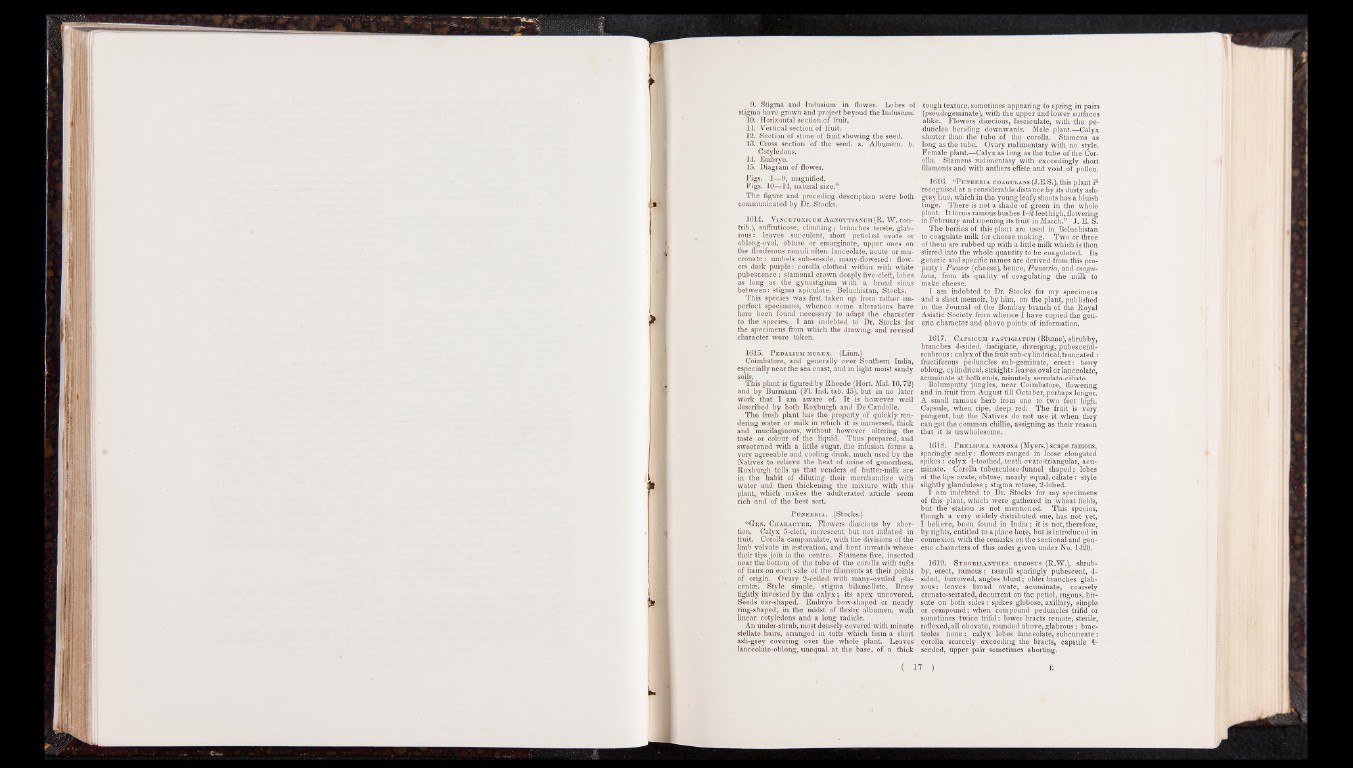
9. Stigma and Indusium in flower. Lobes of
stigma have grown and project beyond the Indusium.
10. Horizontal section.or fruit.
11. Vertical section of fruit.
12. Section of stone of fruit showing the seed.
13. Cross section of the seed. a. Albumen.
Cotyledons.
14. Embryo.
15. Diagram of flower.
Figs. 1—9, magnified.
Figs. 10—14, natural size.”
The figure and preceding description were both
communicated by Dr. Stocks.
1614. Vincetoxicum Arnottianum (R. W. con-
trib.), suffruticose, climbing; branches terete, glabrous:
leaves succulent, short petioled ovate or
oblong-oval, obtuse or emarginate, upper ones on
the floriferous ramuli often lanceolate, acute or mu-
cronate: umbels sub-sessile, many-flowered: flowers
dark purple: corolla clothed within with white
pubescence: stamenal crown deeply five-cleft, lobes
as long as the gynostigium with a broad sinus
between: stigma apiculate. Beluchistan, Stocks.
This species was first taken up from rather imperfect
specimens, whence some alterations have
here been found necessary to adapt the character
to the species. I am indebted to Dr. Stocks for
the specimens from which the drawing and revised
character were taken.
1615. Pedalium murex. (Linn.)
Coimbatore, and generally over Southern India,
especially near the sea coast, and in light moist sandy
soils.
This plant is figured by Rheede (Hort. Mai. 10,72)
and by Burmann (Fl. Ind. tab. 45), but in no later
work that I am aware of. It is however well
described by both Roxburgh and De Candolle.
The fresh plant has the property of quickly rendering
water or milk in which it is immersed, thick
and mucilaginous, without however altering the
taste or colour of the liquid. Thus prepared, and
sweetened with a little sugar, the infusion forms a
very agreeable and cooling drink, much used by the
Natives to relieve the heat of urine of gonorrhoea.
Roxburgh tells us that venders of butter-milk are
in the habit of diluting their merchandize with
water and then thickening the mixture with this
plant* which makes the adulterated article seem
rich and of the best sort.
PUNEERIA. (Stocks.)
“Gen. Character. Flowers dioecious by abortion.
Calyx 5-cleft, increscent but not inflated in
fruit. Corolla campanulate, with the divisions of the
limb valvate in aestivation, and bent inwards where
their tips join in the centre. Stamens five, inserted
near the bottom of the tube of the corolla with tufts
of hairs on each side of the filaments at their points
of origin. Ovary 2-celled with many-ovuled placentae.
Style simple, stigma bilamellate. Berry
tightly invested by the calyx; its apex uncovered.
Seeds ear-shaped. Embryo bow-shaped or nearly
ring-shaped, in the midst of fleshy albumen, with
linear cotyledons and a long radicle.
An under-shrub, most densely covered with minute
stellate hairs, arranged in tufts which form a short
ash-grey covering over the whole plant. Leaves
lanceolate-oblong, unequal at the base, of a thick
tough texture, sometimes appearing to spring in pairs
(pseudogeminate), with the upper and lower surfaces
alike. Flowers dioecious, fasciculate, with the peduncles
bending downwards. Male plant.—Calyx
shorter than the tube of the corolla. Stamens as
long as the tube. Ovary rudimentary with no style.
Female plant.—Calyx as long as the tube of the Corolla.
Stamens rudimentary with exceedingly short
filaments and with anthers effete and void of pollen.
1616. “P uneeria coaguiiAns (J.E.S.), this plant is
recognised at a considerable distance by its dusty ash-
grey hue, which in the young leafy shoots has a bluish
tinge. There is not a shade of green in the whole
plant. It forms ramous bushes 1-2 feet high, flowering
in February and ripening its fruit in March.” J. E. S.
The berries of this plant are used in Beluchistan
to coagulate milk for cheese making. Two or three
of them are rubbed up with a little milk which is then
stirred into the whole quantity to be coagulated. Its
generic and specific names are derived from this property
: Punter (cheese), hence, Puneeria, and coagu-
lans, from its quality of coagulating the milk to
make cheese.
I am indebted to Dr. Stocks for my specimens
and a short memoir, by him, on the plant, published
in the Journal of the Bombay branch of the Royal
Asiatic Society from whence I have copied the generic
character and above points of information.
1617. Capsicum fastigiatum (Blume), shrubby,
branches 4-sided, fastigiate, diverging, pubescenti-
scabrous: calyx of the fruit sub-cylindrical, truncated :
fructiferous peduncles sub-geminate, erect: berry
oblong, cylindrical, straight: leaves oval or lanceolate,
acuminate at both ends, minutely serrulato-ciliate.
Bolumputty jungles, near Coimbatore, flowering
and in fruit from August till October, perhaps longer.
A small ramous herb from one to two feet high.
Capsule, when ripe, deep red: The fruit is very
pungent, but the Natives do not use- it when they
can get the common chillie, assigning as their reason
that it is unwholesome.
1618. Phelipjsa ramosa (Myers.) scape ramous,
sparingly sca ly : flowers ranged in loose elongated
spikes: calyx 4-toothed, teeth ovato-triangular, acuminate.
Corolla tuberculoso-funnel shaped; lobes
of the lips ovate, obtuse, nearly equal, ciliate: Style
slightly glandulose; stigma retuse, 2-lobed.
I am indebted to Dr. Stocks for my specimens
of this plant, which were gathered in wheat fields,
but the station is not mentioned. This species,
though a very widely distributed one, has not yet,
I beueve, been found in India; it is not, therefore,
by rights, entitled to a place hete, but is introduced in
connexion with the remarks on the sectional and generic
characters of this order given under No. 1420.
1619. S trobilanthes rugosus (R.W.), shrubby,
erect, ramous; ramuli sparingly pubescent, 4-
sided, furrowed, angles blunt; older branches glabrous
: leaves broad ovate, acuminate, coarsely
crenato-serrated, decurrent on the petiol, rugous, hirsute
on both sides: spikes globose, axillary,' simple
or compound; when compound peduncles trifid or
sometimes twice trifid: lower bracts remote, sterile,
reflexed, all obovate, rounded above, glabrous; brac-
teoles none: calyx lobes lanceolate, subcuneate:
corolla scarcely exceeding the bracts, capsule 4-
seeded, upper pair sometimes aborting.